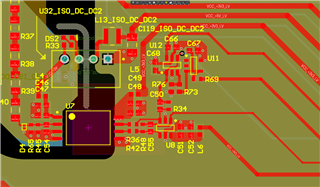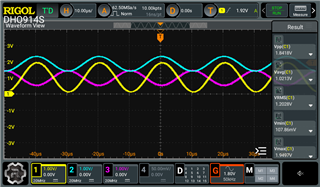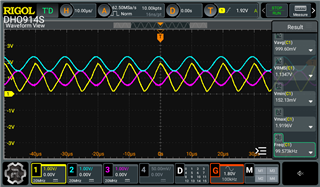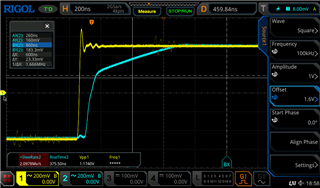- Ask a related questionWhat is a related question?A related question is a question created from another question. When the related question is created, it will be automatically linked to the original question.
This thread has been locked.
If you have a related question, please click the "Ask a related question" button in the top right corner. The newly created question will be automatically linked to this question.
Tool/software:
Hello,
I have a problem with the op amp TL9151SIDBVR. It operates in a differential to single ended circuit. The problem is that for frequencies above 50kHz the sinusoidal signal starts to look like a triangle. This looks like a slew rate problem, but how can this be when its slew rate is 20V/us. What could be the reason for this?
Schematic

Layout of U8 diff to single ended stage

Below Measurements

50 kHz

75kHz

100Khz

Simulation Tina for 100Khz works fine

Hey Michal,
Welcome to e2e
Interesting! I have a starting recommendation. The reference is produced by one of the opamps (U12), which is driving 100nF capacitive load. Unfortunately, the TLV9151 cannot support such a large capacitive load. With respect to Figure 6-29, I would reduce C68 to be ~1nF and at max 2.5nF.

Could you please share your TINA sim? The file may be attached using the following process.
All the best,
Carolina
Hey Michal,
Thanks for the simulation profile and clarification of C67 and C68.
I agree with the original statement that the issue may be slew rate. The problem is described in this application note, Ramping on Slew Rate. The TLV9151 has slew boost architecture and the full slew rate is not achieved without a large enough input differential, in this case it requires atleast 1V VID (IN+ - IN-).
I recommend the evaluation of the TLV9161 as it has better performance in SR for this low of VID:

All the best,
Carolina
Hello,
I confirm the issue with the slew rate, when the TLV9151 is powered from single 3V3 source. Take look on a step response:

Please note that the slope is steeper at the beginning, but it flattens out when the output reaches higher levels. The slew rate in the last part is only about 13mV/us!
When power supply is changed to a higher voltage - 6V:

The slope is steeper by a higher range of the output amplitude.
In the datasheet the slew rate is given only for 16V supply:

Despite name "rail-to-rail output", TLV9151 can not sustain promised slew rate in the full output swing.
It is a shame, that the datasheet does not specify slew rate in the other conditions, or a relation between the slew rate and a supply voltage or output swing.
It looks that the ramping on a small differential signal is not a problem in that case - the problem is due to the output stage of the amplifier.
Hi Aleksander,
Despite name "rail-to-rail output", TLV9151 can not sustain promised slew rate in the full output swing.
Actually "rail-to-rail output means that the output is able to swing the output very close to both the positive and negative supply rails. It has nothing to do with the slew rate.
It is a shame, that the datasheet does not specify slew rate in the other conditions, or a relation between the slew rate and a supply voltage or output swing.
I can see the frustration. Lot's of op amp datasheets with slew boost don't share much information on how it behaves outside of the test conditions shown. However, with this being a high voltage part, we determined most of the use cases where people will need a 3.3V supply voltage would just use a low voltage device.
Also why did you choose the TLV9151 over a low voltage device like the TLV9051 or the OPA323 which have very high slew rates (15V/us and 30V/us respectfully)?
Best Regards,
Robert Clifton
Actually "rail-to-rail output means that the output is able to swing the output very close to both the positive and negative supply rails. It has nothing to do with the slew rate.
Hi Robert,
Technically you are correct. But the more explicit note in the datasheet, something like "better keep your output signal 1,5V away from supply rails to get best performance, better than 5V/us" will be appreciated.
It is "trap for young players" - a secret that you should use opamp with supply voltage range as close to your power supply as possible.
Also why did you choose the TLV9151
I have just made a cross-check for my colleague Michal. But I truly understand his choice - the selected device meets the design requirements, and there was no obvious "red flags". Also TINA does not shown any possible problems. But, as I understand, the simulation model does not represent internal structure, but only the general behavior, made by for ex. voltage dependent sources.
Hi Aleksander,
But the more explicit note in the datasheet, something like "better keep your output signal 1,5V away from supply rails to get best performance, better than 5V/us" will be appreciated.
I agree, this would be helpful to have stated somewhere. I can reach out to the team responsible for the datasheet and let them know your thoughts.
Also TINA does not shown any possible problems. But, as I understand, the simulation model does not represent internal structure, but only the general behavior, made by for ex. voltage dependent sources.
We do our best to make the model as accurate as possible. There's of course limitations.
Best Regards,
Robert Clifton